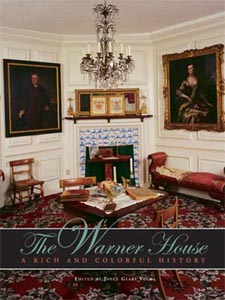|
FRESH STUFF DAILY |
|
|
||
|
|
||
|
|
||
|
SEE ALL SIGNED BOOKS by J. Dennis Robinson click here |
||
Page 1 of 2
Portsmouth has lots of historic treasures, but none is more worth opening than the doors of the Warner House. Visitors to New Hampshire’s only seaport should not pass this building by. Those who cannot find their way here, should own a copy of this colorful book which is, in itself, an opulent tour.
The Warner House: Books about old colonial houses can be as cranky and dry as the houses themselves. This one is the exception. Editor Joyce Geary Volk has turned what might have been simply a dissertation on an early brick mansion into a visual feast for people who love history, both in and outside the academic world. The Warner House: A Rich and Colorful History lives up to its name and, for just $25, this fascinating paperback is a bargain to boot. BUY THE BOOK from the Publishers
A number of houses in town are older or bigger or have grander gardens, but none are built of brick, with walls 18-inches thick. It is, according to the people who grant landmark status, "Perhaps, the finest brick residence of the first quarter of the eighteenth century left in New England." Just inside the front door visitors are hit by a gigantic mural of a man riding a horse in a foxhunt. Another scene depicts the scriptural tale of Abraham offering up his son Isaac, probably copied from a Dutch bible. A third is an enigmatic allegory of images – a servant stops a flax wheel that she has been spinning. She is looking at a dog that is barking at an eagle carrying away a chicken. On the landing leading to the second floor, separated by a palladium window, are two painted Mohawk Indians, larger than life. The combined scenes are the oldest colonial wall paintings still in place in the United States. SEE ALSO: Slaves in the Warner House I’ve always found the house a little overwhelming. Touring the incredibly ornate rooms crammed with family heirlooms is a bit like eating an entire three-course dinner from the dessert tray. One gets light-headed trying to take in all the stuff, the stories and the architecture at once. To protect its treasures from the sun, the Indian shutters of the Warner House are largely kept shut. There are few lights and the paneled walls are dark. The stairway is painted black. By contrast the master bedroom upstairs seems to shimmer. That is because the cobalt blue paint is mixed with particles of blue ground glass. Recently restored, this is the only "smalt" painted room in America. Even with all of its ancestral occupants dead and gone, even empty, the Warner House still exudes an aristocratic air. Everything from the exquisite wood carving and looming portraits, the horsehair chairs and green brocade canopy bed and the wig on the nightstand, everything is designed to prove that the people who lived here were the wealthiest and most important people in town. "You are lucky to be here," the house whispers. "Mind your manners!" The people who lived here were putting on airs. In the beginning at least, they were wealthy British citizens living in a colonial frontier seaport. The house was designed and built by a man from London. It was first owned by Archibald Macpheadris, who was trying to impress New Hampshire’s royal governor John Wentworth who lived just down the street by the Puddle Dock inlet. It worked. Macpheadris wooed the governor’s daughter Sarah, who married him when she was 15. Her brother Benning Wentworth was also appointed royal governor and tried to make this place his royal mansion. When that didn’t work, he moved to a 45-room mansion on the outskirts of town. John Warner, for whom the house is named, was a major player in the West India Trade. The house has been owned and is preserved in part today by the city’s social elite. Artifacts of the Wentworths, Sherburnes, Warners. Penhallows and others who lived here have been located and re-installed. The house was saved in the 1930s by Mrs. Barrett Wendell, the high-society wife of a Harvard professor. When Portsmouth wanted to turn the place into a filling station, she turned it into a museum. As an avowed blue-collar tourist, I admit, it took me decades to venture inside the Warner House. Its ancient occupants were off my radar. I’ve never been much impressed by people who have to prove their value by owning lots of expensive stuff, wearing the best clothes or holding the fanciest parties. I’m much more impressed by people who do great things and make the world a better place. During the last few years some very intelligent people have studied the Warner House inside and out. They have come to terms with its past, recognized its occupants for what they were – wealthy merchants who built great buildings, owned a lot of stuff, and kept enslaved servants in the attic. In studying and diligently restoring this amazing house, the new stewards are doing great things. They have turned this from a snobby to a welcoming place and one of the finest house museums, for my $5, in the entire United States. For the price of a sandwich, we can all gawk at how the other half lived three centuries ago. Few cities can boast such a treasure. Last year the stewards of the Warner House released an extraordinary book (only $25) that dissects the building’s history, its decorative arts and its wealthy inhabitants. I haven’t read every page, but I will. These were, after all, just people who lived here, and their stories, once you get passed all the finery, are as intriguing as the Warner House itself. Copyright © 2007 by J. Dennis Robinson on SeacoastNH.com. All rights reserved. More on Warner House book
Please visit these SeacoastNH.com ad partners.
News about Portsmouth from Fosters.com |
| Friday, April 26, 2024 |


|
Copyright ® 1996-2020 SeacoastNH.com. All rights reserved. Privacy Statement
Site maintained by ad-cetera graphics






 The Warner House (1716) on Daniel Street is king of all the historic houses in Portsmouth. No one disputes that. If the Warner House could rise from its ancient foundation and stroll around the city, all the other house museums would bow down. Sure the Moffatt-Ladd House (1763) would curtsy with a grumble and the Wentworth-Gardner House (1760) would quickly rise back up, take a pinch of snuff, and look absently out to sea. But they all know who rules the roost.
The Warner House (1716) on Daniel Street is king of all the historic houses in Portsmouth. No one disputes that. If the Warner House could rise from its ancient foundation and stroll around the city, all the other house museums would bow down. Sure the Moffatt-Ladd House (1763) would curtsy with a grumble and the Wentworth-Gardner House (1760) would quickly rise back up, take a pinch of snuff, and look absently out to sea. But they all know who rules the roost.














